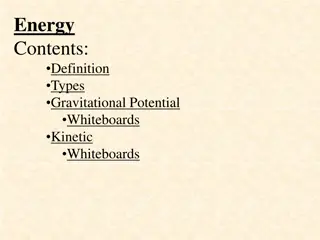
Negotiation of Paris Agreement: Options, Costs, and Human Development
Explore the negotiation highlights of the Paris Agreement on climate change, including primary options, current/future choices, and human development factors. Delve into energy justice principles, pragmatic approaches, and challenges in implementing distributive justice in the energy sector.
Download Presentation

Please find below an Image/Link to download the presentation.
The content on the website is provided AS IS for your information and personal use only. It may not be sold, licensed, or shared on other websites without obtaining consent from the author. If you encounter any issues during the download, it is possible that the publisher has removed the file from their server.
You are allowed to download the files provided on this website for personal or commercial use, subject to the condition that they are used lawfully. All files are the property of their respective owners.
The content on the website is provided AS IS for your information and personal use only. It may not be sold, licensed, or shared on other websites without obtaining consent from the author.
E N D
Presentation Transcript
Primary Options During the Negotiation of the Paris Agreement on Climate Change $10,000 $7,500 $2010/kw $5,000 $2,500 $0 1970 1980 1990 2000 2010 2020 2030 Nuclear Coal-equivalent Onshore Wind
Current and Future Options, Overnight Cost Central Station, Nuclear, Coal, Gas Nuclear $10,000 Coal (unabated) Coal w/ccs Onshore Wind $7,500 Solar PV Utility PV Battery Equivalent $2010/kw Gas w/Carbon Capture $5,000 Efficiency Distributed Supply, Managed Demand $2,500 $0 1970 1980 1990 2000 2010 2020 2030
Human Development and Electricity Consumption 200 Germany U.S. Sweden 180 160 Argentina Human Development Index 140 Russia 120 Brazil 100 China 80 60 40 20 0 0 2000 4000 6000 8000 10000 12000 Electricity Consumption - kWh/Capita
A PRAGMATIC, PROGRESSIVE APPROACH TO ENERGY JUSTICE Distributive Justice Principles and Practice Principles Extensions Use Availability Devote attention surplus & least well-off 1 Affordability Balance fiscal viabilityb and hierarchy of needs2,d Quality Service not supply, f Extensity and intensity of use5,h Responsibility Individual Households must take some responsibility for cost8,l Steadily increasing share of cost recovery as income and usage rises9,m Social Externalities, 10,n Optimization, Robustness11 Equity Intragenerational Primary goods,13 Capacitiesp Some inequality if socially beneficial14,t Intergenerational Sustainability Depletion, 16 environmental harm17,u Measurement & Policy People deserve no less energy than the medianhousehold consumes2,a Living wage level, c Rates should be no higher than the median and people should pay no more than 2x median as a % of incomee, 3 Ensure adequacy, reliability and timeliness, 4, g Recognize and promote movement up the hierarchy of needs, 6,j Attend to strong complementary goods, skills7,k Least-cost, 12 Conservationo All the way, q Hierarchy of uses, r reflect local needs (conformity, convenience, adequacy) s Open for all15 Incentives to create recoverable/valuable resources, 18 renewable resources, 19,v Preserving resources, 20,w to the maximum extent consistent with technology that maximizes use of local resources benefit21,x Transactional Due Process Capitalist Challenges for Implementing Distributive Justice Effectiveness of Subsidies Dumb subsidies Confusion of means-ends, z leakage, aa exaggeration of cost and impacts27 Monopoly bias Incumbent biasaf Technocracy & Exclusion22 Information, 23 Subsidiarity, 24 Participatory governance25, y Smart subsidies, ab,26 Recognize relatively small sums needed when targeted to promote access and adoption, Targeting with means testing, 28, ad Reflect value of externalities (positive and negative) 29,ae Competitive neutrality in funding of subsidies (Uniform tax rate for all potential suppliers, general revenue); Competition in supply to minimize cost (Reverse Auctions) Competition in demand to maximize utility (consumer sovereignty through Vouchers. Adaptive, flexible, effective, quality control, monitoring & evaluation Failure to require least cost & over recovery Competition & regulation (IRP) to eliminate abuse of market power & unnecessary supply-side subsidies Promotion of decentralized alternatives: Employment of local resources, Diseconomies of scale Improving fit between supply & demand, Autonomy Promoting efficiency lowers bills, reduces subsidies, strengthens finance Administration Chronic inefficiency, rigidity, corruption Market Structure Excess Cost: Centralization Concentration of wealth & power Inefficiency Waste, excess cost Efficiency in Cost Recovery Cost causers Misplaced subsidies do not bear cost Shared responsibility Marginal cost, Capture economies of scale, Social allocation of common costs to maximize users, not usage favoring small users (equal benefit, equal burden, standalone cost rules at the top) Consumer/subsidy, public/private, microfinance of amortized fixed cost
10 Cost of Lighting Per Lumen, 1800=1 9 8 7 6 5 1st Industrial Revolution 4 0.003 0.002 3 0.001 2 2nd Industrial Revolution 0 1950 2000 2050 1 3rd Industrial Revolution 0 1700 1750 1800 1850 1900 1950 2000 2050
Refrigerator Electricity Consumption kWh per 1000 Cubic Feet 1000 900 800 y = 7E+258x-77.64 R = 0.9473 700 600 500 400 300 200 100 0 1980 1990 2000 2010 2020 2030 2040 2050
DYNAMIC SYSTEM MANAGEMENT UTILIZING INFORMATION, COMMUNICATIONS & CONTROL TECHNOLIGIES DEMAND SUPPLY Efficiency Target peaks Aggressive demand response Manage water heating Smart controllers Rates Target fixed cost recovery Time of use Grid Management Expand balance area Improve forecasting Integrated power transactions Import/export Dispatchable Storage Solar thermal Utility strategic Distributed Storage Community and Individual Air conditioning & Water Electric vehicles Generation Geographic Diversity Technological Diversity Peak Targeted Solar Quick start/rapid ramp






















